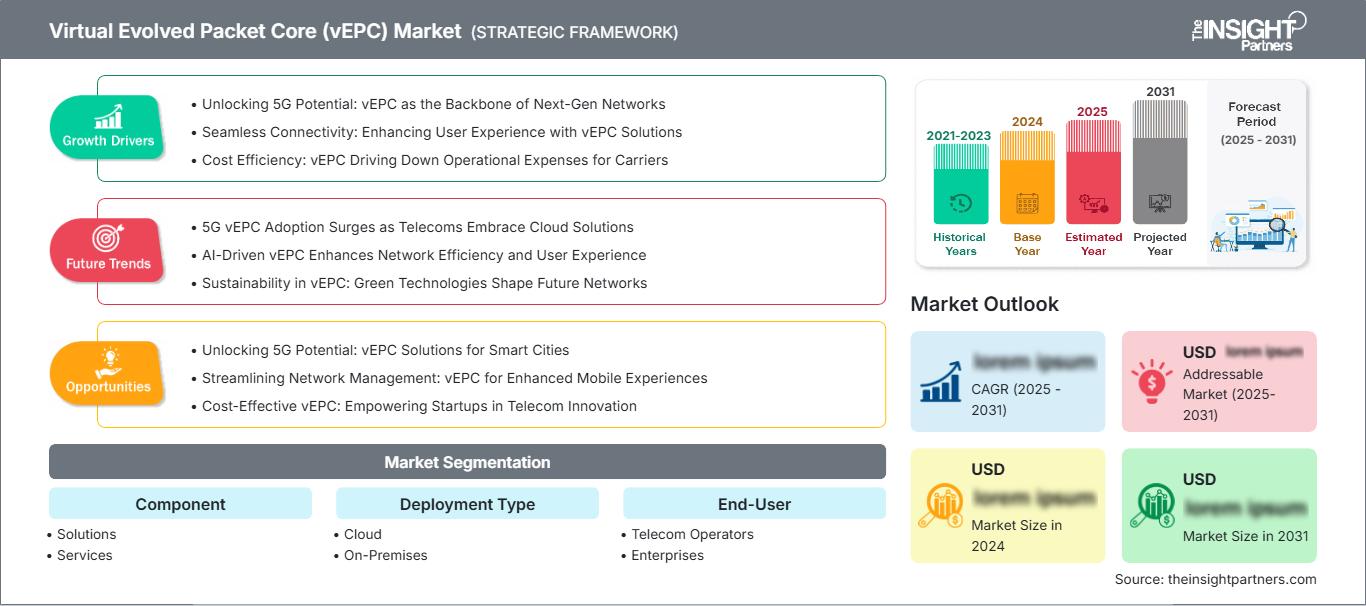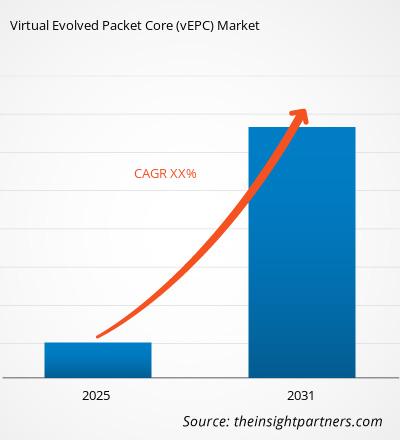Si prevede che il mercato Virtual Evolved Packet Core (vEPC) registrerà un CAGR del XX% dal 2025 al 2031, con una dimensione del mercato in espansione da XX milioni di dollari nel 2024 a XX milioni di dollari entro il 2031.
Il rapporto è suddiviso per componente (soluzioni, servizi) e analizza ulteriormente il mercato in base al tipo di distribuzione (cloud, on-premise). Esamina inoltre il mercato per utente finale (operatori di telecomunicazioni, aziende) e caso d'uso del settore (LTE e VOLTE, accesso wireless a banda larga, IoT e M2M, MPN e MVNO). Per ciascuno di questi segmenti chiave viene fornita una ripartizione completa a livello globale, regionale e nazionale. Il rapporto include le dimensioni del mercato e le previsioni per tutti i segmenti, presentando i valori in dollari statunitensi. Fornisce inoltre statistiche chiave sullo stato attuale del mercato dei principali attori, insieme ad approfondimenti sulle tendenze prevalenti e sulle opportunità emergenti.
Scopo del rapporto
Il rapporto Virtual Evolved Packet Core (vEPC) Market di The Insight Partners mira a descrivere il panorama attuale e la crescita futura, i principali fattori trainanti, le sfide e le opportunità. Ciò fornirà spunti a vari stakeholder aziendali, come:
- Fornitori/produttori di tecnologia: per comprendere le dinamiche di mercato in evoluzione e conoscere le potenziali opportunità di crescita, consentendo loro di prendere decisioni strategiche informate.
- Investitori: per condurre un'analisi completa delle tendenze in merito al tasso di crescita del mercato, alle proiezioni finanziarie di mercato e alle opportunità esistenti lungo la catena del valore.
- Enti di regolamentazione: per regolamentare le politiche e le attività di controllo sul mercato con l'obiettivo di ridurre al minimo gli abusi, preservare la fiducia degli investitori e sostenere l'integrità e la stabilità del mercato.
Componente di segmentazione del mercato Virtual Evolved Packet Core (vEPC)
- Soluzioni
- Servizi
Tipo di implementazione
- Cloud
- On-Premises
Utente finale
- Operatori di telecomunicazioni
- Aziende
Caso d'uso
- LTE e VOLTE
- Accesso wireless a banda larga
- IoT e M2M
- MPN e MVNO
Potrai personalizzare gratuitamente qualsiasi rapporto, comprese parti di questo rapporto, o analisi a livello di paese, pacchetto dati Excel, oltre a usufruire di grandi offerte e sconti per start-up e università
Mercato Virtual Evolved Packet Core (vEPC): Approfondimenti strategici

-
Ottieni le principali tendenze chiave del mercato di questo rapporto.Questo campione GRATUITO includerà l'analisi dei dati, che vanno dalle tendenze di mercato alle stime e alle previsioni.
Fattori di crescita del mercato Virtual Evolved Packet Core (vEPC)
- Sbloccare il potenziale del 5G: vEPC come spina dorsale delle reti di nuova generazione
- Connettività senza interruzioni: migliorare l'esperienza utente con le soluzioni vEPC
- Efficienza dei costi: vEPC riduce le spese operative per gli operatori
Trend futuri del mercato Virtual Evolved Packet Core (vEPC)
- L'adozione di vEPC 5G aumenta con l'adozione di soluzioni cloud da parte delle telecomunicazioni
- Il vEPC basato sull'intelligenza artificiale migliora l'efficienza della rete e l'esperienza utente
- Sostenibilità in vEPC: le tecnologie verdi plasmano le reti future
Mercato Virtual Evolved Packet Core (vEPC) Opportunità
- Sbloccare il potenziale del 5G: soluzioni vEPC per le città intelligenti
- Semplificazione della gestione della rete: vEPC per esperienze mobili migliorate
- vEPC conveniente: potenziare le startup nell'innovazione delle telecomunicazioni
Mercato dei Virtual Evolved Packet Core (vEPC)
Le tendenze regionali e i fattori che influenzano il mercato Virtual Evolved Packet Core (vEPC) durante il periodo di previsione sono stati ampiamente spiegati dagli analisti di The Insight Partners. Questa sezione illustra anche i segmenti e la geografia del mercato Virtual Evolved Packet Core (vEPC) in Nord America, Europa, Asia-Pacifico, Medio Oriente e Africa, America Meridionale e Centrale.
Ambito del rapporto di mercato Virtual Evolved Packet Core (vEPC)
| Attributo del rapporto | Dettagli |
|---|---|
| Dimensioni del mercato in 2024 | US$ XX Million |
| Dimensioni del mercato per 2031 | US$ XX Million |
| CAGR globale (2025 - 2031) | XX% |
| Dati storici | 2021-2023 |
| Periodo di previsione | 2025-2031 |
| Segmenti coperti |
By Componente
|
| Regioni e paesi coperti |
Nord America
|
| Leader di mercato e profili aziendali chiave |
|
Densità degli attori del mercato Virtual Evolved Packet Core (vEPC): comprendere il suo impatto sulle dinamiche aziendali
Il mercato dei Virtual Evolved Packet Core (vEPC) è in rapida crescita, trainato dalla crescente domanda degli utenti finali, dovuta a fattori quali l'evoluzione delle preferenze dei consumatori, i progressi tecnologici e una maggiore consapevolezza dei vantaggi del prodotto. Con l'aumento della domanda, le aziende stanno ampliando la propria offerta, innovando per soddisfare le esigenze dei consumatori e sfruttando le tendenze emergenti, alimentando ulteriormente la crescita del mercato.

- Ottieni il Mercato Virtual Evolved Packet Core (vEPC) Panoramica dei principali attori chiave
Punti di forza
- Copertura completa: il rapporto analizza in modo esaustivo prodotti, servizi, tipologie e utenti finali del mercato Virtual Evolved Packet Core (vEPC), fornendo un panorama olistico.
- Analisi degli esperti: il rapporto è redatto sulla base della conoscenza approfondita di esperti e analisti del settore.
- Informazioni aggiornate: il rapporto garantisce la pertinenza aziendale grazie alla copertura di informazioni e tendenze dei dati recenti.
- Opzioni di personalizzazione: questo rapporto può essere personalizzato per soddisfare le esigenze specifiche del cliente e adattarsi in modo appropriato alle strategie aziendali.
Il rapporto di ricerca sul mercato Virtual Evolved Packet Core (vEPC) può quindi contribuire a guidare il percorso di decodificazione e comprensione dello scenario del settore e delle prospettive di crescita. Sebbene possano esserci alcune valide preoccupazioni, i vantaggi complessivi di questo rapporto tendono a superare gli svantaggi.
- Analisi storica (2 anni), anno base, previsione (7 anni) con CAGR
- Analisi PEST e SWOT
- Valore/volume delle dimensioni del mercato - Globale, Regionale, Nazionale
- Industria e panorama competitivo
- Set di dati Excel
Report recenti
Testimonianze
Motivo dell'acquisto
- Processo decisionale informato
- Comprensione delle dinamiche di mercato
- Analisi competitiva
- Analisi dei clienti
- Previsioni di mercato
- Mitigazione del rischio
- Pianificazione strategica
- Giustificazione degli investimenti
- Identificazione dei mercati emergenti
- Miglioramento delle strategie di marketing
- Aumento dell'efficienza operativa
- Allineamento alle tendenze normative






















 Ottieni un campione gratuito per - Mercato Virtual Evolved Packet Core (vEPC)
Ottieni un campione gratuito per - Mercato Virtual Evolved Packet Core (vEPC)